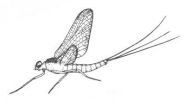![]()
![]()
![]()
Use LEFT and RIGHT arrow keys to navigate between flashcards;
Use UP and DOWN arrow keys to flip the card;
H to show hint;
A reads text to speech;
6 Cards in this Set
- Front
- Back
|
Mayflies (pic)
|

|
|
|
Mayflies description
|
Two winged life stages: Nymph and Dun
Spend 1+ years in larval stage underwater, then swim to surface to hatch. Float on top of water to dry wings, then fly into trees to mature in 1-2 days, then back over river to mate and spin back to surface (spinner) and lay eggs, die with wings spread (spent). 4 types of nymph: clingers, crawlers, burrowers, swimmers; identified by 2-3 slender tails and plate-like gills on side of abdomen; Duns identified by wings held erect when at rest; Jerky up-and-down flight when airborne; and by 2-3 long slender tails. The sub-adult (dun) has dull opaque wings The adult (spinner) has hyaline (transparent and shiny) wings. |
|
|
Mayfly Nymph (pic)
|

|
|
|
Mayfly Nymph description
|
Abdomen ends with 3 (or 2) tails
Each leg ends with only a single claw Gills are typically plate-like and located on sides of the abdomen Instars: 15-25 Mature nymphs drift to ideal areas of stream hours before hatch. Identified by well-developed and darkened wing cases. 4 types: clingers, crawlers, burrowers, swimmers; Clingers have extremely flat profile and broad legs to adhere tightly to rocks in faster, well-aerated currents. Crawlers have thicker bodies and thinner legs in slightly gentler current where can forage with less danger of being swept away Burrowers are heavy-gilled, use tusks to dig tunnels in bottom of slower eddies and pools--> midsummer drake hatches Swimmers build for minnow-like speed Fish by drifting down, and imitating swimming up to surface |
|
|
Mayfly Dun (pic)
|

|
|
|
Mayfly Dun description
|
Two or three long tails
Wings held vertically; front pair large and triangular; hind pair usually reduced, rarely absent Body slender and delicate Float on top of surface to unfold and dry wings before flying to safety of trees. Cool weather emergence is sluggish. Duns have semi-opaque or translucent wings due to protective outer layer that protects them from getting wet during emergence. Match 2-3 tails, mottled wings, marked veins, hind wing: elliptical or slight hook on foremargin, tiny, or absent? Legs: spotted, striped, or unmarked? Abdominal markings, size, color Spinner body color more saturated than dun, wings glassy clear but distinctly veined and tinted or mottled. Front legs of males are elongated for grasping females. |

